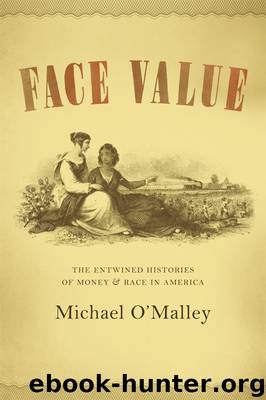Face Value by Michael O'Malley

Author:Michael O'Malley
Language: eng
Format: epub
Publisher: The University of Chicago Press
Published: 2012-03-17T16:00:00+00:00
FIGURE 4.3. One of Emanuel Ninger’s fakes, courtesy United States Secret Service; and a real bill of the same denomination, courtesy Paper Money Guaranty LLC.
This mysterious counterfeiter’s bills had reached Subtreasury offices in New York as early as 1880, by some accounts. According to the New York Herald, the Treasury Department in Washington had even canceled one of them—that is, retired it from circulation, its serial number duly recorded in a ledger. Only when the real bill arrived for retirement did the Secret Service realize just how good the artist was.33 For over fifteen years the unknown counterfeiter had made perhaps as few as ten or as many as sixty or seventy astonishingly impressive notes a year, passing them in saloons and liquor stores in downtown Manhattan. His success and skill made him something of a folk hero.34 In 1896 they caught him; he was of course Emanuel Ninger, the ostensible Flagtown farmer. His capture set off a brief flurry of newspaper celebrity, in part because it recapitulated a number of the decade’s most vexing public issues.
Ninger took advantage of the plethora of American paper money, but he also took advantage of prevailing criminological and social stereotypes about the relationship between appearance and character. Police, the Secret Service, and average citizens mistook him, and not just his bills, for the thing he imitated.
On Friday, March 27, 1896, Ninger came to New York to pass seven of his hand-drawn counterfeits, all fifty and one hundred dollar notes. He managed to spend all but one, either by using them to buy something or, even more audaciously, handing over a large bill and asking for change. He entered a downtown saloon at 10 p.m. on Saturday, bought a cigar with real money, and then requested change for a fifty dollar bogus note. The bartender gave him the change but spotted the fake when the ink ran on the wet bar top. Ninger offered him five dollars to keep his mouth shut, then ran out when the bartender refused. Guessing he would head for the ferry, the bartender found a policeman and had Ninger arrested.35
At least the Secret Service told it that way; newspapers gave a different account. Ninger told the Secret Service and the police several stories. First he gave his name as “Joseph Gilbert,” farmer, a country rube duped into taking bad bills by a wily urbanite, the classic victim of the confidence man. Later he admitted, encouraged by the Secret Service, to being Emanuel Ninger’s confederate—the “boodle carrier” who merely passed the bills. Newspapers published both versions in front page stories on the days following the arrest, partly because the Secret Service also had doubts about their suspect’s identity. Ninger/Gilbert didn’t conform to common notions of what a skilled forger should look like.
“His appearance was such I did not think he could be the maker,” reported William P. Hazen, Chief of the New York Bureau of the Secret Service; “specially as I had him write his name and he did it very clumsily.
Download
This site does not store any files on its server. We only index and link to content provided by other sites. Please contact the content providers to delete copyright contents if any and email us, we'll remove relevant links or contents immediately.
| African-American Studies | Asian American Studies |
| Disabled | Ethnic Studies |
| Hispanic American Studies | LGBT |
| Minority Studies | Native American Studies |
Cecilia; Or, Memoirs of an Heiress — Volume 1 by Fanny Burney(32366)
Cecilia; Or, Memoirs of an Heiress — Volume 3 by Fanny Burney(31742)
Cecilia; Or, Memoirs of an Heiress — Volume 2 by Fanny Burney(31709)
The Great Music City by Andrea Baker(31085)
We're Going to Need More Wine by Gabrielle Union(18900)
All the Missing Girls by Megan Miranda(15357)
Pimp by Iceberg Slim(14203)
Bombshells: Glamour Girls of a Lifetime by Sullivan Steve(13926)
Talking to Strangers by Malcolm Gladwell(13128)
Fifty Shades Freed by E L James(13117)
Norse Mythology by Gaiman Neil(13114)
For the Love of Europe by Rick Steves(12209)
Crazy Rich Asians by Kevin Kwan(9119)
Mindhunter: Inside the FBI's Elite Serial Crime Unit by John E. Douglas & Mark Olshaker(9099)
The Lost Art of Listening by Michael P. Nichols(7356)
Enlightenment Now: The Case for Reason, Science, Humanism, and Progress by Steven Pinker(7081)
The Four Agreements by Don Miguel Ruiz(6537)
Bad Blood by John Carreyrou(6472)
Weapons of Math Destruction by Cathy O'Neil(6080)
